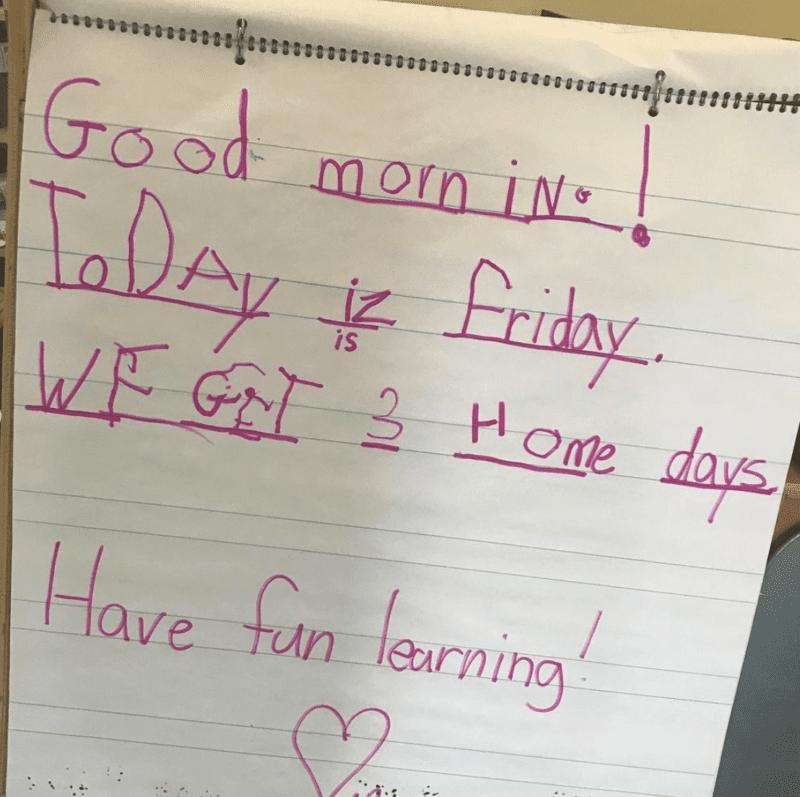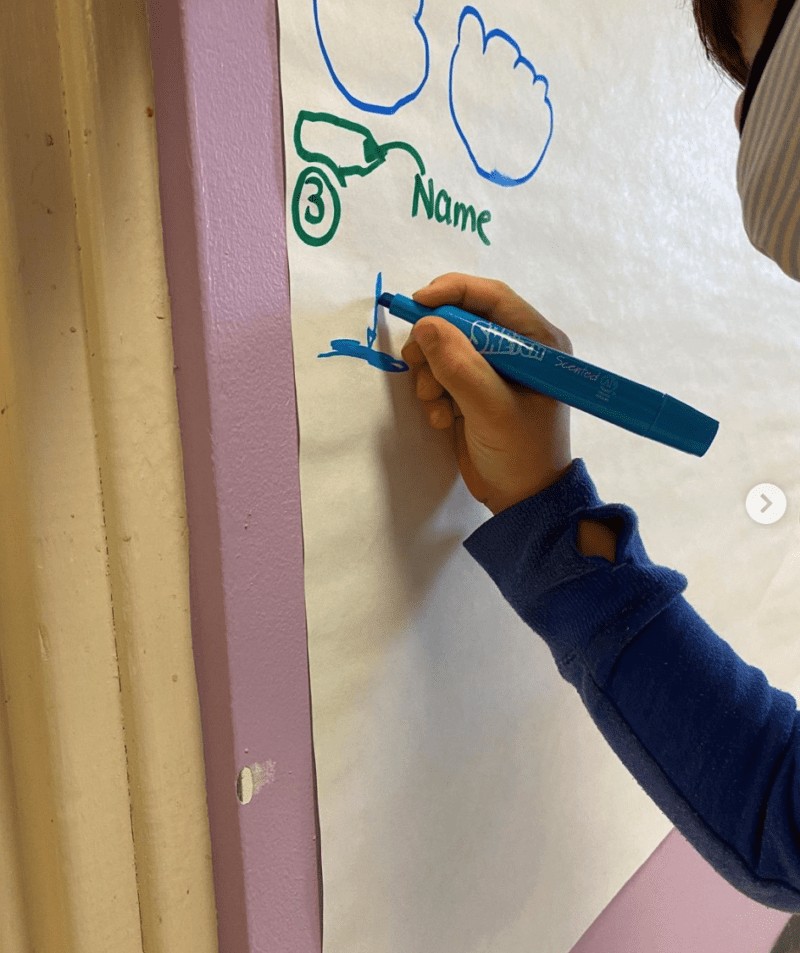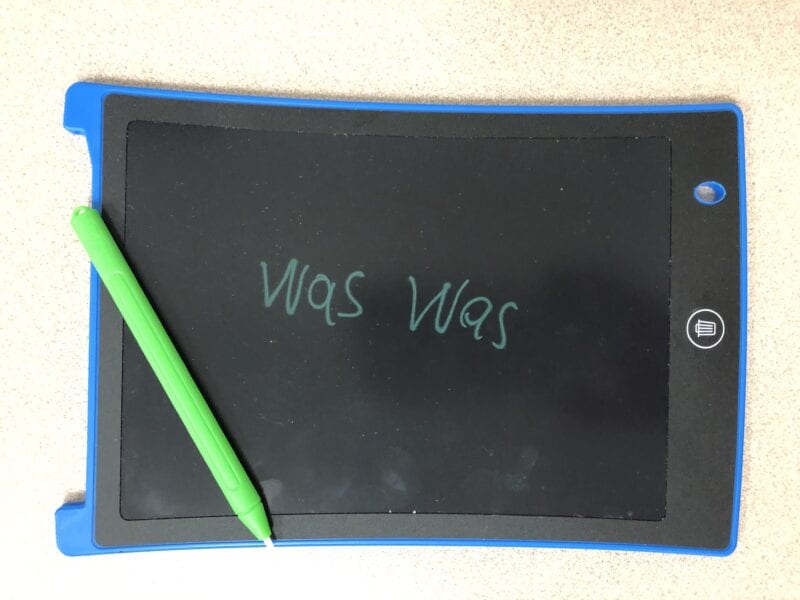Interactive writing (IW) has decades of research behind it, yet many teachers may not recognize the power it has to develop children’s writing and reading skills. Below, I’m sharing strategies for using IW to teach foundational skills such as concepts about print, phonemic awareness, and phonics. In addition—and perhaps even more importantly—I am going to reveal what expert teachers do to make the practice effective.
What is Interactive Writing?
Many of us know the most popular kind of interactive writing (IW)—morning message. For example:

Source: @tenderlovingkindergarten
Interactive writing capitalizes on the children’s ideas and creates readable texts. Interactive writing is immediate, personal, and relatable. The experience is designed to model how language and print work in tandem. As simple as it looks, the conversation that leads to the negotiated text advance students’ understanding of complex language concepts.
Interactive writing highlights the writing process for children and the importance of writing to communicate a message. What makes it so powerful as a writing and reading practice is all teachers can do to steer the experience based on the observed strengths and needs during reading instruction. For example, imagine students in a small reading group are having difficulty solving unknown words. Perhaps they are trying to sound out words letter by letter which, given the irregular nature of the English language, is not always productive. Noticing this, the teacher quickly records these observations. After the students are finished with the text, the teacher asks them a question about the main character, and together they engage in IW to generate a statement in response to the reading.
As the teacher and students record the statement, the teacher keeps in mind the unproductive word-solving she saw. During the writing, the teacher purposefully uses examples that show students how to hear and record larger, more efficient units of information. The teacher also demonstrates how the students can take this same action when reading. Making these connections provides students with new alternatives when they are problem-solving while reading. Furthermore, every type of co-created IW text becomes a source of reading material that children can go back and revisit and reread independently.
A Boon To the Start of the School Year

Source: @mandyrobek_edu
IW is an amazing back-to-school routine, helping to develop a sense of classroom community. The message you write can be a daily classroom recap at the end of the day (one of my favorites because when children are questioned about what happened at school instead of saying nothing, the day’s highlights are fresh in their minds); the results of a science experiment; a letter to a favorite author, or any topic that is meaningful to children.
Whatever the selected genre and form, the ensuing conversation with students provides rich opportunities to support language development including, background knowledge and vocabulary. If you are interested in learning how to implement IW, much more advice can be found in my book Interactive Writing: Developing Readers Through Writing (Benchmark Education, 2020). For now, let’s focus on the 3Ms of managing it successfully.
[contextly_auto_sidebar]
The 3Ms
IW isn’t for the faint of heart. In fact, I often feel like I have run a marathon after an IW session. So, planning for this literacy activity is paramount to its success. There are many opportunities to differentiate instruction for individuals, and making the best in-the-moment teaching decisions keeps my brain going at lightning speed. Yet here’s the thing I want you to know—my brain can’t go at lightning speed unless it is “freed up” to focus on instruction. Yes, the apparent spontaneity of responsive teaching is actually built on a plan.
“The apparent spontaneity of responsive teaching is actually built on a plan.”
Model Routines: Tackling Traffic

Source: @hayesmakesithappen
The plan begins with clearly established routines and procedures. At the beginning of the year, I have children practice how to come up to and participate on the IW chart. This may sound trivial, but if it takes a child 15 minutes to come up and add a letter or a word to the text we are creating, chances are I will have some time management issues on hand. Rethinking where IW takes place in the classroom may help; often, the flow of traffic to and from the IW text needs streamlining. Ideally, you can set up a carpeted space in front of the chart, as meeting on the carpet sets a tone for the activity and contributes to a sense of community.
While students can participate from their desks or team tables, I encourage using a designated space—even if this requires students to push a table back a few feet at the start of an IW session to open up an area where everyone can clearly see the chart and sit comfortably. The space where children will write has to be accessible, so as you plan the layout of the classroom, keep in mind that “Creating a conducive environment for interactive writing means making space” (p. 47).
Manage Time: Watch out for Wiggles
Another important planning consideration is time. When engaging in IW, I keep a close watch on the children’s body language. Are they getting wiggly and restless? At the beginning of the year, an IW session may only last 10-15 minutes. As the children’s stamina increases, IW lessons may extend to 25-30 minutes. Regardless of the length of the IW session, I always maintain a divided attention to engage the entire class, even when one child is at the chart.
For example, during a simple morning message, we may write the date. The sentence begins with the word “Today,” and I have the children clap the parts of the word before purposefully inviting a child to contribute the first part to the chart. While the child makes his or her way to the chart, I build phonological awareness with the others.
Developing phonological awareness is a foundational skill, and IW offers plenty of authentic opportunities to do this. Quickly I say the parts of several compound words, pausing between them (out – side; play – ground; jelly – fish). After each, the students blend the two parts as they say the word.
Of course, while this is happening, I am also checking on the child at the chart and providing support as needed. The interactive in interactive writing traditionally involves “sharing the pen,” but there are many ways to make this powerful practice interactive.
Manage Materials: Participation Pack Prep

Another option for making IW interactive for all children is to use what I call Participation Packs. These materials allow the students on the floor to work alongside the child at the chart. As the student at the chart begins to write the word “to,” students on the floor can simultaneously be writing the word. I often say things like, “Write the word ‘to’ as many times as you can before your classmate sits down.”
When I first started using the Participation Packs, I have to admit managing the materials was a little overwhelming! But after years of trial and error and some collaborative planning, I developed a workable system. I store the Participation Packs in a tub and, at the beginning of an IW session, each student receives one. Participation Pack suggestions include:
- 8 x 11 whiteboards.
- Plastic Solo plates (works like a whiteboard).
- Chalkboards and colored chalk.
- Small Magnadoodles.
- Boogie Boards.
- Clipboards.
Collaborate with your grade level team to develop a list of rotating materials for the Participation Packs. Then, each person can locate and purchase one of the materials on the list to share amongst the group. Changing up the materials in the Participation Packs every month keeps the children motivated to use the materials.
Having an organized system and a plan for IW assists with all things related to management. Taking the time at the beginning of the year to launch a framework that provides a structure for both teacher and students alike supports teaching and learning. Most importantly, an established framework allows the focus of IW to center on the reciprocal relationships in writing and reading and allows important instructional decisions to be made.
Take it a step further with interactive bulletin boards!
Want more articles like this? Make sure to subscribe to our newsletters!


